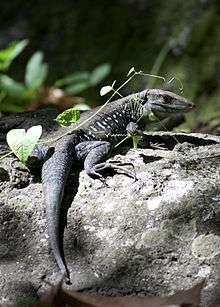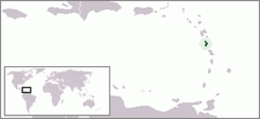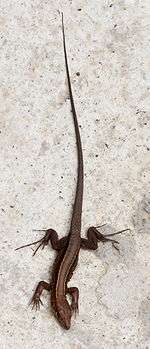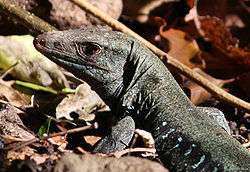Dominican ground lizard
The Dominican ground lizard or Dominican ameiva (Pholidoscelis fuscatus) is a species of lizard. It is endemic to the Caribbean island of Dominica, an island noted for its intact and abundant reptile population, where it is most commonly found in dry coastal woodland.
| Dominican ground lizard | |
|---|---|
 | |
| An adult male near the Coulibistrie River, Dominica. | |
| Scientific classification | |
| Kingdom: | Animalia |
| Phylum: | Chordata |
| Class: | Reptilia |
| Order: | Squamata |
| Family: | Teiidae |
| Genus: | Pholidoscelis |
| Species: | P. fuscatus |
| Binomial name | |
| Pholidoscelis fuscatus Garman, 1887 | |
 | |
| Endemic to Dominica in the Lesser Antilles, a chain of islands in the Caribbean. | |
| Synonyms | |
|
Ameiva fuscata (Garman, 1887) | |
Adults are mostly blue-gray, and can reach lengths up to 400 mm from snout to tail. They are omnivorous, feeding on fallen fruit, carrion, and small animals including other lizards.
History
The Dominican ground lizard is locally known as the abòlò.[1] The indigenous Caribs used to stew it as a remedy for certain illnesses.[2]
The species was first described in 1887 by Samuel Garman, the assistant director of herpetology and ichthyology at Harvard's Museum of Comparative Zoology.[3] The three cotype specimens, all males of varying ages, were acquired by the Museum in 1879, and were collected from Dominica during the "Blake expeditions" conducted by William Healy Dall.[4]
Description

Adult Dominican ground lizards have bright blue spots on their flanks and inner thighs, and a gray or sometimes reddish-brown dorsal surface that is flecked with black.[5] They have a pale blue ventral surface, with dark blue-gray on the throat and chest. They exhibit little sexual dichromatism, apart from a tendency in the males to be more uniformly blue-gray. Adult males can reach a snout-vent-length (SVL) of up to 200 mm, females up to 154 mm SVL, with their tails about the same length.[6] Adult males also have broader heads and jowls.
Juveniles appear markedly different from adults and are impossible to sex from simple observation.[7] They are coppery-brown overall, with a dark brown lateral stripe on each side bounded by yellow lines. These stripes have yellow flecks and spots that turn blue as it matures. Juveniles are often confused with adult Gymnophthalmus pleii and Mabuya mabouya, two other lizard species present in the same habitat, because they are fast moving and of similar coloration and size. The latter two may be differentiated from juvenile Dominican ground lizards by their shinier skin and less differentiated, snake-like head and body.[8]
Distribution and habitat

The Dominican ground lizard is restricted to the island of Dominica, one of the few islands in the Lesser Antilles to have retained its original reptile and amphibian fauna over the last 200 years.[9] It is one of two lizard species endemic to Dominica, the other being the Dominican anole.[10] It is fairly common on Dominica, with a habitat including dry coastal woodland and scrub, littoral woodland, and cultivated land below around 300 m elevation.[11] The coastal woodlands of Dominica have been noted as unusually favorable for reptiles, with a biomass among the highest recorded for terrestrial reptile populations; Dominican ground lizards have been estimated to occur in that environment at a mean density of 379 per hectare.[12] Its range is also expanding to higher elevations, as more rain forest on Dominica is cleared for agricultural development.[13]
Diet
Dominican ground lizards are omnivorous.[14] They forage through forest litter for fallen fruit such as mangoes, scavenge for carrion, and may also hunt invertebrates or other small lizards.[15] It is known to eat the eggs, embryos, and hatchlings of the endangered Lesser Antillean Iguana.[16] They apparently avoid eating carrion of their own species.[17]
Behavior and reproduction

Dominican ground lizards are heliothermic, and are usually only observed during the hottest part of the day.[7] They are generally terrestrial, but have been observed climbing trees to heights over 1.5 m, possibly to hunt; this behavior has been described in at least two other species.[18]
Males mature at a size of 94 mm SVL, and females mature at 105 mm.[19] They do not have a restricted breeding season, but instead reproduce year-round.[20] It is estimated that they lay two or three clutches of eggs each year.[21] Each clutch contains about four eggs, with the number of eggs tending to increase with the size of the female.[22]
Conservation
Though many of its relatives on neighboring islands have gone extinct, the Dominican ground lizard continues to flourish, possibly owing to the absence of the mongoose on Dominica.[23] Researchers have noted, however, that it may be especially vulnerable to the alteration and fragmentation of its habitat, caused by the continued clearing of forest on Dominica for agricultural uses and consequent erosion. An increase in the use of spraying of banana and tree crop plantations may also pose a threat.[24]
Notes
- Evans 1997, p. 20; Crask 2007, p. 21.
- According to Honychurch.
- Garman 1887, p. 5-6.
- Barbour 1915, p. 456; Barbour 1929, p. 212. The specimens are cataloged M.C.Z. No. 6,087.
- Descriptions are given in Malhotra 1999, p. 32, and Evans 1997, p. 20.
- Snout-vent-length is a standard measurement of reptile body length, extending from the tip of the nose (snout) to the anus (vent), and excluding the tail.
- Malhotra 1999, p. 32.
- Comparative photos of the heads of these three species are provided in Malhotra 1999, p. 33, noting the possibility of confusion. The skink species is given there as M. bistriata, but is likely instead M. mabouya; see Malhotra 2007, p. 183 (listing M. mabouya as the only skink present on Dominica).
- Malhotra 2007, p. 177.
- Bullock 1990; Crask 2007, p. 21; Malhotra 2007, p. 182.
- Evans 1997, p. 20; Malhotra 1999, p. 32; Crask 2007, p. 21; Malhotra 2007, p. 182.
- Bullock 1990.
- Malhotra 2007, p. 182.
- Rudman 2009, p. 217, describes A. fuscata as "facultatively omnivorous," and as "dietary generalists."
- Malhotra 1999, p. 32; Rudman 2009, p. 217.
- Rudman 2009, p. 217, citing, e.g., Breuil 2002. Patr. Nat., Paris 54:1-330.
- See Rudman 2009, p. 217, noting observations that they did not feed on a A. fuscata carcass "adjacent to an area of intense activity...That they did not feed on the carcass of a dead Ameiva was surprising" given their feeding on Iguana delicatissima.
- Observations of "three small A. fuscata (SVL 70-100 mm)" climbing trees are described in Rudman 2009, p. 217; one "appeared to be stalking an Anolis oculatus." Rudman, citing to Powell and Censky (2002) Herpetological Review 33:50, notes arboreal activity has also been described of Ameiva alboguttata and Pholidoscelis plei.
- Somma 1976, p. 255.
- Somma 1976, p. 253-4, 255.
- This is based on estimations of the clutches of related species Holcosus quadrilineatus and Holcosus festivus, rather than direct observation of Dominican ground lizards. Somma 1976, p. 254.
- Somma 1976, p. 255
- See Malhotra 2007, p. 187, noting that "Dominica has escaped the introduction of the cane toad and mongoose, which have been implicated in the extinction of ground-living amphibians and reptiles on other West Indian islands," possibly due to the local non-importance of sugar cane cultivation; see also Malhotra 1999, p. 32, noting extinction of Ameiva relatives on other islands. Barbour 1937, p. 140, expressly attributes its survival to the lack of threat from the mongoose.
- Malhotra 2007, p. 185-6.
References
- Barbour, Thomas; Noble, G. Kinsley (1915). "A Revision of the Lizards of the Genus Ameiva". Bulletin of the Museum of Comparative Zoology. 59 (6): 417–79.
- Barbour, Thomas; Loveridge, Arthur (1929). "Typical Reptiles and Amphibians in the Museum of Comparative Zoology". Bulletin of the Museum of Comparative Zoology. 69 (10): 206–360.
- Barbour, Thomas (1937). "Third List of Antillean Reptiles and Amphibians". Bulletin of the Museum of Comparative Zoology. 82 (2): 77–166.
- Bullock, D.J.; Evans, Peter G.H. (1990). "The distribution, density and biomass of terrestrial reptiles in Dominica, West Indies". Journal of Zoology. 222 (3): 421–43. doi:10.1111/j.1469-7998.1990.tb04042.x.
- Crask, Paul (2007). Dominica. England: Bradt Travel Guides. p. 21. ISBN 1-84162-217-6.
- Evans, Peter G.H.; James, Arlington (1997). Dominica, Nature Island of the Caribbean: Wildlife Checklists. Dominica Ministry of Tourism. p. 20.
- Garman, Samuel (1887). "On the West Indian Teiids in the Museum of Comparative Zoology". Bulletin of the Essex Institute. 19: 1–12.
- Honychurch, Lennox. "Lennox Honychurch's A-to-Z of Dominica's Heritage". Archived from the original on 2009-08-16. Retrieved 2010-01-28.
- Malhotra, Anita; Thorpe, Roger S. (1999). Reptiles & Amphibians of the Eastern Caribbean. Macmillan Publishers. pp. 32–33. ISBN 0-333-69141-5.
- Malhotra, Anita; Thorpe, Roger S.; Hypolite, Eric; James, Arlington (2007). "A report on the status of the herpetofauna of the Commonwealth of Dominica, West Indies". Applied Herpetology. 4 (2): 177–194. doi:10.1163/157075407780681365.
- Rudman, Seth M.; Powell, Robert; Parmerlee, John S. (2009). "Ameiva fuscata (Dominican ground lizard): Arboreal Activity and Diet". Herpetological Review. 40 (2): 217.
- Somma, Carolynn A.; Brooks, Garnett R. (1976). "Reproduction in Anolis oculatus, Ameiva fuscata and Mabuya mabouya from Dominica". Copeia. 1976 (2): 249–56. doi:10.2307/1443943. JSTOR 1443943.
External links

- Pholidoscelis fuscatus at the Encyclopedia of Life